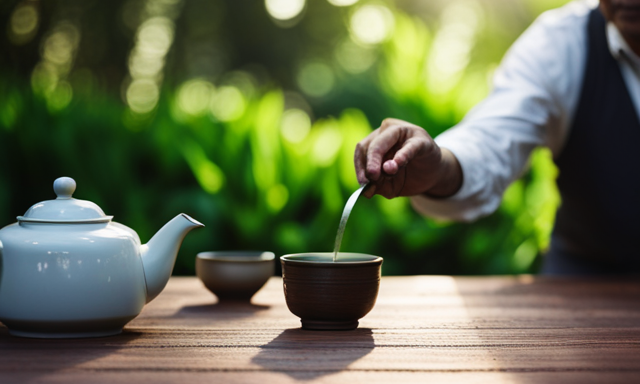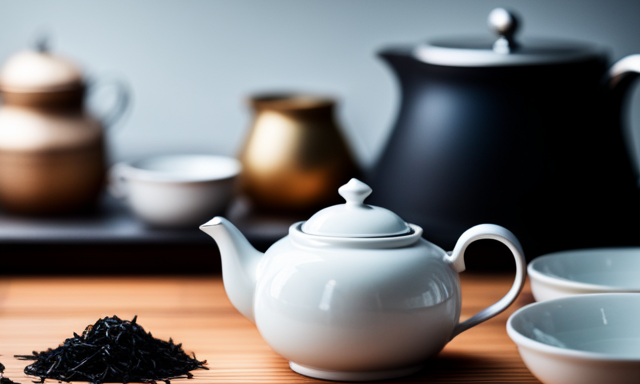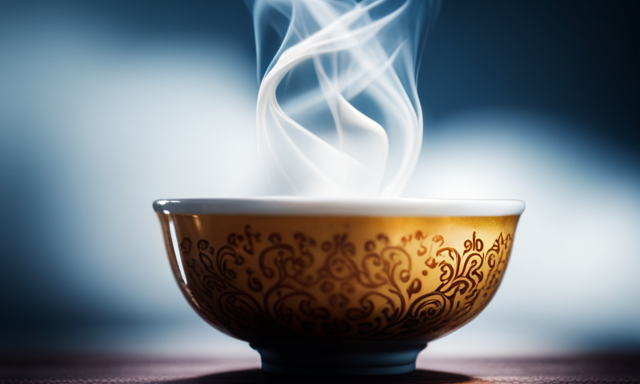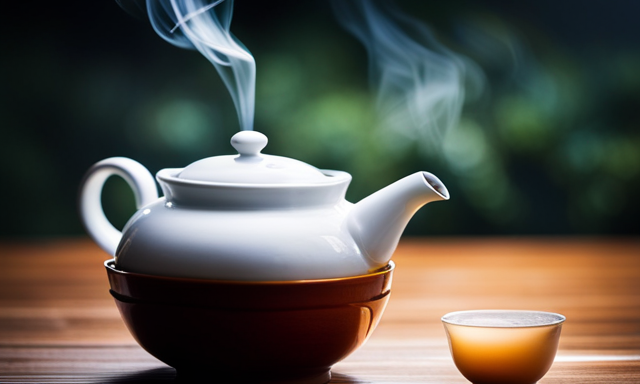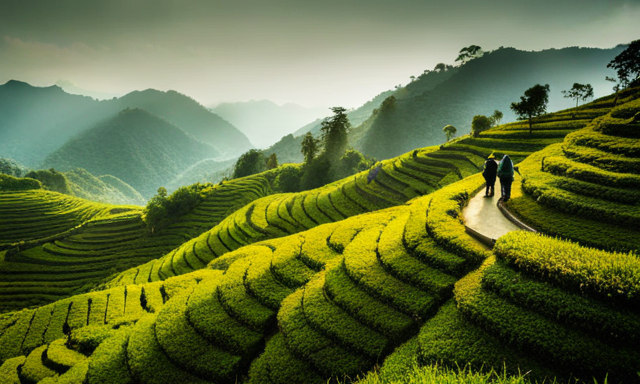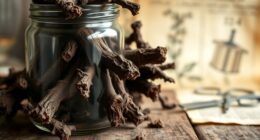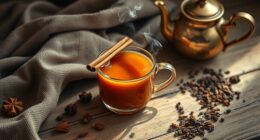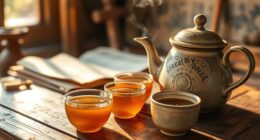Like a soothing melody that dances on the taste buds, brewing Fujian Oolong tea is an art that I have come to master. With each sip, I am transported to the lush green hills of Fujian, where the tea leaves are carefully handpicked and nurtured to perfection.
As a tea enthusiast, I find great joy in sharing the secrets of this exquisite tea with others. In this article, I will guide you through the intricate steps of selecting the finest tea leaves, preparing your teapot and utensils, and steeping the leaves to unlock their full flavor potential.
We will also explore the aromatic nuances and health benefits that Fujian Oolong tea offers. So, join me on this journey of discovery as we unlock the enchanting world of Fujian Oolong tea together.
Key Takeaways
- Use fresh, filtered water
- Heat water to the appropriate temperature (180-190°F)
- Add 1 teaspoon of tea leaves per cup
- Steep for 2-3 minutes for a light flavor or 4-5 minutes for a stronger flavor
Introduction to Fujian Oolong Tea
If you’re looking to explore the world of flavorful, aromatic teas, you can’t go wrong with Fujian Oolong Tea!
With a history dating back centuries, this tea holds a special place in Chinese culture and is renowned for its unique taste and health benefits.
Fujian Oolong Tea originates from the Fujian province in China, where the tea leaves are carefully handpicked and crafted to perfection. The cultural significance of this tea is evident in the traditional tea ceremonies that have been passed down through generations.
The rich, smooth flavor of Fujian Oolong Tea is a result of the unique processing techniques used, which include withering, rolling, oxidation, and firing.
Now that you know the fascinating history and cultural significance of Fujian Oolong Tea, let’s move on to selecting the right tea leaves for brewing.
Selecting the Right Tea Leaves
To truly experience the pinnacle of flavor, you’ll want to ensure you’ve carefully handpicked the most exquisite leaves for your exquisite brew. The quality of the tea leaves plays a crucial role in the final taste of your Fujian Oolong tea. Here are some factors to consider when selecting the right tea leaves:
-
Tea leaf quality: Look for tea leaves that are whole and unbroken, as they indicate superior quality. Avoid leaves that are discolored or have a dull appearance.
-
Tea leaf origin: Fujian Oolong tea is known for its unique terroir, which contributes to its distinct flavor. Look for tea leaves sourced from reputable tea gardens in Fujian, China, to ensure authenticity and exceptional taste.
-
Leaf size: The size of the leaves can affect the brewing process and flavor. Smaller leaves often have a stronger flavor, while larger leaves provide a more delicate taste.
-
Leaf aroma: The aroma of the tea leaves gives an indication of the flavors that will be present in the brewed tea. Look for leaves with a fragrant, floral, or fruity aroma for a delightful cup of tea.
Now that you have the perfect tea leaves, let’s move on to preparing your teapot and utensils.
Preparing Your Teapot and Utensils
Once you have selected the finest tea leaves, it’s time to prepare your teapot and utensils for the ultimate tea brewing experience.
To start, it is essential to clean your teapot thoroughly. Make sure to rinse it with hot water and scrub away any residue or impurities. This will ensure that your tea brews without any unwanted flavors.
Next, choosing the right utensils is crucial. Opt for a tea strainer that fits well inside your teapot, allowing the leaves to expand and release their full flavor. Additionally, select a tea scoop or tongs that are easy to handle and will not damage the delicate leaves.
Now that your teapot and utensils are ready, it’s time to move on to heating the water to the correct temperature for brewing the perfect cup of Fujian Oolong tea.
Heating the Water to the Correct Temperature
When heating the water, it is important to reach the correct temperature for the ultimate tea brewing experience. The correct water temperature is crucial in bringing out the full flavor and aroma of Fujian Oolong tea. Different brewing methods require different temperatures, so it is essential to know the specifics.
Here are some guidelines to follow:
- For a light and delicate brew, use water heated to around 175°F (80°C).
- If you prefer a stronger flavor, opt for water heated to 195°F (90°C).
- For a more robust and full-bodied cup, aim for water at 212°F (100°C).
Consider investing in a temperature-controlled kettle to ensure precision. Always use fresh, filtered water for the best results.
Now that the water is heated to the perfect temperature, we can move on to steeping the tea leaves and extracting their rich flavors.
Steeping the Tea Leaves
Get ready to immerse yourself in the enchanting world of steeping tea leaves and unlocking their captivating flavors. Steeping is a critical step in brewing Fujian Oolong tea, as it allows the leaves to release their rich aromas and delicate taste.
To start, add the desired amount of tea leaves into a teapot or infuser. Next, pour hot water over the leaves, ensuring that the water is at the optimal temperature for Oolong tea. Allow the leaves to steep for about 3-5 minutes, depending on your preference for strength. During this time, the leaves will gradually unfurl, releasing their flavors into the water.
Remember to cover the teapot or infuser to retain heat and maximize flavor extraction. Timing the steeping process is crucial to achieving the perfect cup of Fujian Oolong tea.
In the next section, we will explore the importance of timing and how it influences the overall tea brewing techniques.
Timing the Steeping Process
Timing techniques play a significant role in achieving the perfect cup of Fujian Oolong tea. The duration for steeping can vary depending on personal preference and the specific type of tea leaves used. Some enthusiasts prefer a shorter steeping time of around 2 minutes, while others enjoy a longer infusion of 3 to 5 minutes. These steeping variations allow for different flavor profiles to emerge, ranging from delicate and floral to rich and robust. It’s important to experiment with different timing techniques to find your preferred balance.
So, let’s move on to the next section about pouring and serving the tea, where we’ll explore the final steps in enjoying this exquisite brew.
Pouring and Serving the Tea
To fully appreciate the nuanced flavors of this exquisite beverage, it is essential to master the art of pouring and serving. This final step adds an element of elegance and sophistication to the enjoyment of Fujian Oolong tea.
Here are three serving techniques that will enhance your tea ceremony experience:
-
Hold the teapot high above the cup and pour the tea in a steady, controlled stream. This creates a beautiful cascade of tea, enhancing the visual appeal.
-
Serve the tea in small, delicate cups. This allows the aroma to concentrate and the flavors to be savored with every sip.
-
Use a graceful, sweeping motion when serving the tea. This not only adds a touch of ceremony but also helps to evenly distribute the tea’s flavors.
By mastering the art of pouring and serving, you set the stage for appreciating the aroma and flavor of Fujian Oolong tea in the next step.
Appreciating the Aroma and Flavor
Indulge your senses as you take a moment to inhale the fragrant bouquet and taste the complex flavors of this exquisite beverage. Can you imagine the delightful experience that awaits you?
Appreciating the aroma, flavor, and appearance of Fujian oolong tea is an art in itself. Each variety of oolong tea offers a unique sensory experience.
The aroma ranges from floral and fruity to roasted and earthy, while the flavor can be smooth and buttery or bold and toasty. The appearance of the leaves, tightly rolled or loosely twisted, also adds to the overall visual appeal.
Understanding the different varieties of oolong tea allows you to appreciate the nuances in taste and aroma.
Now, let’s explore the health benefits of Fujian oolong tea and discover how it can enhance your well-being.
Health Benefits of Fujian Oolong Tea
Enhance your well-being by exploring the numerous health benefits that come with enjoying a cup of Fujian oolong tea.
This exquisite tea not only delights the senses with its rich aroma and flavor, but it also provides several advantages for your health.
One of the key benefits is its ability to improve digestion. Fujian oolong tea contains polyphenols and catechins that help stimulate the production of digestive enzymes, promoting a healthy digestive system and reducing bloating and indigestion.
Additionally, this tea is known for its metabolism-boosting properties. The natural compounds found in Fujian oolong tea can help increase fat oxidation, leading to weight management and improved energy levels.
So, while savoring the unique taste of this tea, you can also support your digestive health and boost your metabolism.
Now, let’s delve into the next section to learn about storing and enjoying your tea.
Storing and Enjoying Your Tea
Savor the full experience of this exquisite beverage by mastering the art of proper storage and the art of enjoying your cup of tea.
Storing tea is crucial to maintain its freshness and flavor. To ensure the longevity of your Fujian Oolong tea, invest in airtight tea storage containers. These containers should be made of non-reactive materials such as ceramic or glass, which will prevent any unwanted flavors from seeping in. Store your tea away from direct sunlight, heat, and moisture to preserve its delicate taste. Additionally, it is important to keep your tea away from strong odors as tea can easily absorb them.
When it’s time to enjoy your cup of tea, take a moment to appreciate its aroma, color, and taste. Sip slowly, allowing the flavors to dance on your palate. Indulge in the tranquility that comes with each sip of this exceptional brew.
Frequently Asked Questions
What are the different types of oolong tea available from Fujian?
Oh, the wonderful world of oolong teas from Fujian! There are various flavors to explore, from the floral and fruity Tie Guan Yin to the earthy and robust Da Hong Pao. Popular farms include Zheng Yan and Wu Yi Mountain.
How do I know if I am using too much or too little tea leaves?
To determine if I’m using the right amount of tea leaves, I rely on the proper tea to water ratio. Adjusting the strength of oolong tea is as simple as adding or reducing the amount of leaves used.
Can I re-steep the tea leaves for a second infusion?
Yes, you can re-steep the tea leaves for a second infusion. This allows you to enjoy the re steeping benefits and get more out of your tea. Just remember to adjust the infusion time for optimal flavor.
Are there any specific foods that pair well with Fujian oolong tea?
Pairing suggestions for Fujian oolong tea are endless. Its subtle floral notes and smooth taste make it a versatile companion to both sweet and savory dishes. Plus, it’s loaded with antioxidants, promoting overall health.
Can I add milk or sweeteners to my Fujian oolong tea?
Sure, you can add milk or sweeteners to your Fujian oolong tea. However, it’s important to note that adding milk may alter the flavor profile, so it’s best to taste it first before making that decision.
Conclusion
In conclusion, brewing Fujian Oolong tea is not just a simple task, but a sacred ritual that brings joy and satisfaction to every tea lover.
As I sip the smooth and fragrant tea, I am reminded of a blooming flower, gradually unfolding its petals to reveal its true beauty.
This exquisite tea not only delights the senses but also offers numerous health benefits, from boosting metabolism to reducing stress.
So let us cherish each cup, savoring the delicate flavors and aromas, as we embark on a journey of tranquility and rejuvenation.

